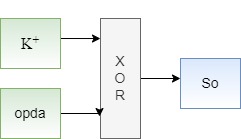It is a technique that combines public key, Private Key, and a hash into a mix hackers can't unpack.
HMAC Algorithm :
The keywords to remember :
|
H = Embedded hash function (e.g.; MD5, SHA-1, RIPEMO-160)
IV = Initial value Input to hash function.
M = Message Input to HMAC (including the padding specified in the
embedded hash function)
Yi = ith block if M, 0<=i<=(L-1)
L = number of blocks in M
b = Number of bits in a block.
n = Length of hash code produced by embedded hash function.
K = secret key; recommended length >=n; if key length is greater then
b, then key is input to the hash
function to produce an n-bit key.
K+ = K padded with zeros on the left so that the result is
b bit in length
ipad = 00110110 (36 in Hexadecimal) repeated b/8 times.
opad = 01011100 (5C in Hexadecimal) repeated b/8 times.
|
The HMAC can be expressed as :
HMAC(K,M) = H[(K+ XOR opad) || H[(K+ xor ipad) || M]]
Figure 1 explains the Structure of HMAC
Fig: 1. HMAC Structure
Step 1. Make the Length of K
+ equal to b. . if length of K+<b; add 0 bit required to left of k.
. if the length of K+=b; in this case, we do not take any action, and proceed to step 2.
. if the length of K+>b ; we need to trim k, for this, we pass k through the message digest algorithm selected for this particular instance of HMAC.
Fig. 2: Procedure of Step 1
Step 2. Xor with K
+ ipad to produce Si.
. Xor K+ (the output of step 1) and ipad to produce a variable called Si.
. Equation : K+ xor ipad = si
Fig. 3: Procedure of Step 2.
Step 3. Append original message M to Si.
. Take the original message M and simplify append it to the end of Si.
. Equation : [(K+ xor ipad) || M] = Si || M
Fig. 4: Procedure of Step 3.
Step 4. Apply Message Digest algorithm. . The selected message digest (e.g. MD5,SHA-1, etc) is applied to the output of step 3.
. Equation : H[(K+ xor ipad) || M] = H(Si || M)
Fig. 5: Procedure of Step 4.
Step 5. Xor K
+ with opad to produce So. . K+ Xor (the output of step 1) with opad to produce a variable called So.
. Equation : K+ xor opad = So
Fig. 6: Procedure of Step 5.
Step 6. Append H to So. . Append the message digest calculated in step 4 to the end of So.
. Equation : (K+ xor opad) || H[(K+ xor ipad) || M] = So || H(Si || M)
Fig. 7: Procedure of Step 6.
Step 7. Apply Message digest Algorithm.
. The selected message digest (e.g. MD5, SHA-1,etc) is applied to the output of step 6.
. Finally, we got MAC.
. Equation : HMAC(K,M) = H[(K+ xor opad) || H[(K+ xor ipad) || M]]
Fig. 8: Procedure of Step 7.
Efficient Implementation :
A more efficient implementation is possible. Two quantities are precomputed.
f(IV, (K+ xor ipad)
f(IV, (K+ xor opad)
Fig. 9: Efficient Implementation of HMAC
%3CmxGraphModel%3E%3Croot%3E%3CmxCell%20id%3D%220%22%2F%3E%3CmxCell%20id%3D%221%22%20parent%3D%220%22%2F%3E%3CmxCell%20id%3D%222%22%20value%3D%22%22%20style%3D%22shape%3Dtable%3BstartSize%3D0%3Bcontainer%3D1%3Bcollapsible%3D0%3BchildLayout%3DtableLayout%3BfontSize%3D14%3BgradientColor%3D%23ffffff%3B%22%20vertex%3D%221%22%20parent%3D%221%22%3E%3CmxGeometry%20x%3D%22390%22%20y%3D%22450%22%20width%3D%2260%22%20height%3D%2240%22%20as%3D%22geometry%22%2F%3E%3C%2FmxCell%3E%3CmxCell%20id%3D%223%22%20value%3D%22%22%20style%3D%22shape%3DpartialRectangle%3Bcollapsible%3D0%3BdropTarget%3D0%3BpointerEvents%3D0%3BfillColor%3Dnone%3Btop%3D0%3Bleft%3D0%3Bbottom%3D0%3Bright%3D0%3Bpoints%3D%5B%5B0%2C0.5%5D%2C%5B1%2C0.5%5D%5D%3BportConstraint%3Deastwest%3BfontSize%3D14%3B%22%20vertex%3D%221%22%20parent%3D%222%22%3E%3CmxGeometry%20width%3D%2260%22%20height%3D%2240%22%20as%3D%22geometry%22%2F%3E%3C%2FmxCell%3E%3CmxCell%20id%3D%224%22%20value%3D%22%22%20style%3D%22shape%3DpartialRectangle%3Bhtml%3D1%3BwhiteSpace%3Dwrap%3Bconnectable%3D0%3Boverflow%3Dhidden%3BfillColor%3Dnone%3Btop%3D0%3Bleft%3D0%3Bbottom%3D0%3Bright%3D0%3BpointerEvents%3D1%3BfontSize%3D14%3B%22%20vertex%3D%221%22%20parent%3D%223%22%3E%3CmxGeometry%20width%3D%2260%22%20height%3D%2240%22%20as%3D%22geometry%22%3E%3CmxRectangle%20width%3D%2260%22%20height%3D%2240%22%20as%3D%22alternateBounds%22%2F%3E%3C%2FmxGeometry%3E%3C%2FmxCell%3E%3C%2Froot%3E%3C%2FmxGraphModel%3Eb
Note 1: Please study the below Table regarding the advantages and limitations of HMACs. ☺
|
Advantages:
1 HMAC
is faster to compute and verify digital signature because they use hash
function rather than public key.
2 HMACs
can be used in some cases where the public key cryptography is prohibited.
3 HMACs
are much smaller than digital signature.
Drawbacks:
1 Key
exchange is main issue, so can’t prevent against replay.
2 HMAC
cannot be used if the number of receiver is greater than one.
3 If
multiple parties share the same symmetric key. How does a receiver know that
the message was prepared and sent by the sender.
|
*************************************************************************************************************











Comments
Post a Comment